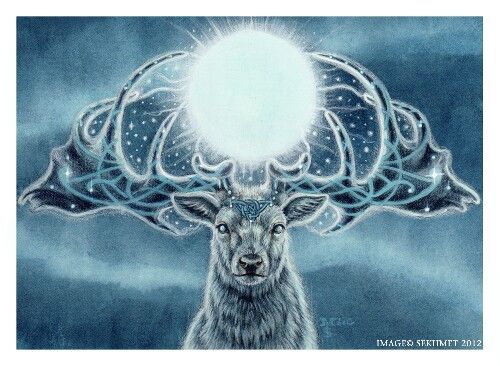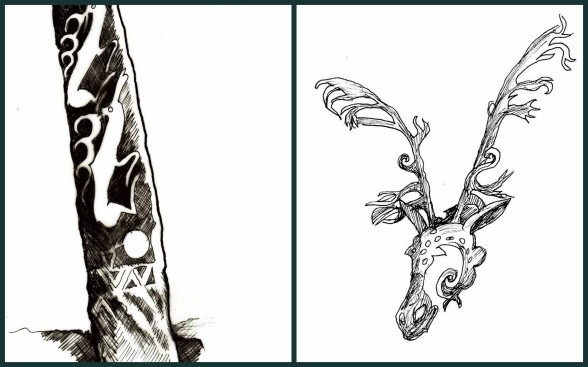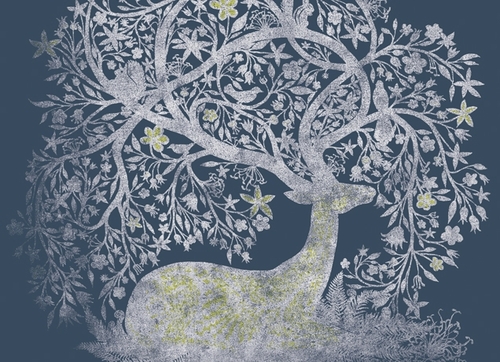In the old nature religion (in which the divine was often perceived as feminine) it was the female horned reindeer who reigned supreme as the great goddess of the winter solstice. It was when we “Christianized” the pagan traditions of winter, that the white bearded man i.e. “Father Christmas” was born.

Today he chariots Rudolph and his steed of flying reindeer across our mythical skies and we have forgotten the power of the Deer Mother, the female horned Reindeer. Stronger and larger than the buck, it is she who leads the herds.

Today he chariots Rudolph and his steed of flying reindeer across our mythical skies and we have forgotten the power of the Deer Mother, the female horned Reindeer. Stronger and larger than the buck, it is she who leads the herds.

And it is her beloved image that adorns the Christmas cards and Yule decorations we are so familiar with today. Because, unlike the male who sheds his antlers in winter, it is the Deer Mother, who carries the life-giving sun safely through winter’s darkest, longest night in her horns.
 Across the North, since the Neolithic, from the British Isles, Scandinavia, Russia, Siberia, the land bridge of the Bering Straights and into the Americas, the female reindeer was venerated as the ‘life-giving mother’. She was the facilitator of fertility, the anima of wild places, forests and mountains, the otherworldly steed of fairies and magical folk.
Across the North, since the Neolithic, from the British Isles, Scandinavia, Russia, Siberia, the land bridge of the Bering Straights and into the Americas, the female reindeer was venerated as the ‘life-giving mother’. She was the facilitator of fertility, the anima of wild places, forests and mountains, the otherworldly steed of fairies and magical folk.
Scythian Reindeer Tattoo
Her horns adorned altars and the heads of shamanic priestesses and her image was etched in standing stones, woven into ceremonial cloth and clothing, cast in jewelry and painted on drums.

Rarely depicted running on land, the reindeer was seen leaping or flying through the air with neck outstretched and legs flung out fore and aft. Often carrying the cosmos, the sun, moon and stars in her horns, her antlers were the tree of life, depicting the lower, middle and upper worlds.

The Deer Mother has also been visualized as a seated woman/goddess, wearing a horned headdress into which is woven the tree of life and the bird (emblematic of shamanic flight). This trio of symbols is often repeated in winter solstice imagery and Christmas folk art and is still with us – though we have clearly forgotten their original meaning.
In Siberian legends the reindeer took flight each winter after ingesting the hallucinogenic Amanita Muscaria mushroom, the archetypal red toadstool with white spots. Shamans would join them on a vision quest, by taking the mushrooms themselves and then, climbing the tree of life they would take flight like a bird into other realms.
There are theories that Santa’s costume derives from shamans in the Arctic regions who would dress in red suits with white spots, collect the mushrooms and then deliver them through chimneys as gifts on the winter solstice. Talk about a wild night.

In Siberia, female shamans wore red and white costumes trimmed with fur, horned headdresses (or high peaked felt red hats!) and practiced the tradition of shamanic flight. It is from their winter solstice celebrations that we have inherited the stories of flying reindeer who take to the sky on the longest night of the year. Saule, the Slavic Goddess of light and family went across the heavens in a sleigh pulled by female reindeer and threw pebbles of amber into the chimneys of the people. (Amber being the representative of the tears of the sun.)




Love and Gratitude for this informative post of the ways and wisdom of the Beautiful Past.
ReplyDeleteA lovely addition to the same-old traditions of the Christmas holidays! Thank you for this feminine image to hold to. <3
ReplyDeletekeep the wisdom of our ancestors alive .........yuletide greetings
ReplyDeleteA beautiful tribute to the feminine spirit we so dearly need now.
ReplyDeleteI lions this- discovered these tales of the deer Mother and Elen Starpath several years ago, when she appeared on my canvas! Blessings of the season, and of the mother!
ReplyDeleteBeautiful, informative and meaningful. I loved this.
ReplyDeleteBeautiful and informative. I loved this Lisa. Thank you
ReplyDeleteThank you, that was fascinating. I thought I knew a lot about the Pagan Solstice celebrations - now I know more!
ReplyDeleteThank you so much for this. I would like to have a publication of this that you have written. It is importyanty!
ReplyDelete